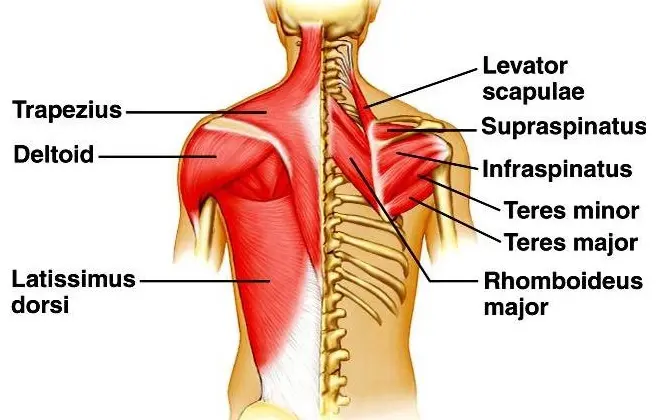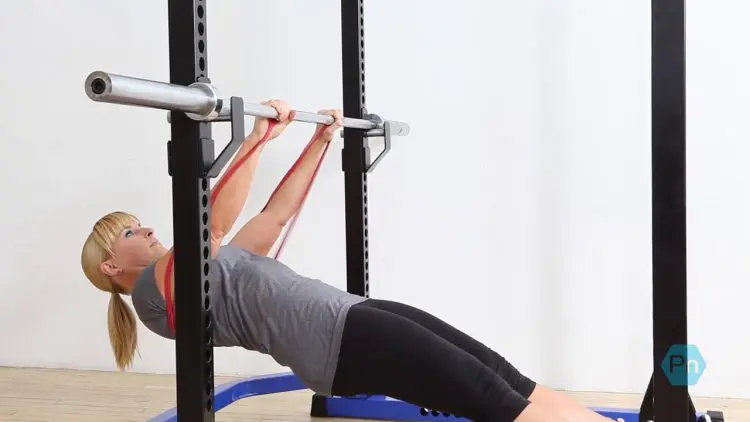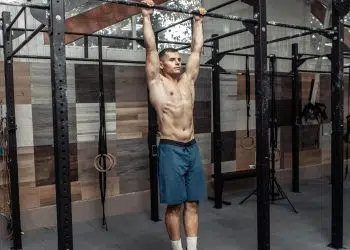Here at Fitness Volt, we’re always on the lookout for new, exciting training methods and exercises. That’s because innovations in training and equipment often mean bigger gains and faster progress.
But, despite this, we’re also HUGE fans of old-school training. After all, the methods used by people like Frank Zane, Larry Scott, Tom Platz, Arnold Schwarzenegger, Serge Nubret, and Serio Oliva clearly worked like a charm!
Of all the exercises you can do for your back and biceps, the supinated (underhand grip) pull-up, also known as the chin-up, is a real muscle and strength-building champ. So, in this article, we reveal why and how to do this exercise and provide you with a handful of worthy variations and alternatives.
Supinated Pull-Ups Anatomy
Supinated pull-ups are a compound exercise. That means they work several muscles and involve movement at two or more joints. Most people do supinated pull-ups for their backs, but there is much more to this exercise.
The main muscles involved in supinated pull-ups are:
Level Up Your Fitness: Join our 💪 strong community in Fitness Volt Newsletter. Get daily inspiration, expert-backed workouts, nutrition tips, the latest in strength sports, and the support you need to reach your goals. Subscribe for free!
Latissimus dorsi – known as the lats for short, this is the agonist or prime mover during supinated pull-ups. It’s the reason most people do this exercise. The lats are located on the side of your upper back and, when fully developed, look like muscular wings and give your back its width. Well-developed lats are visible not only from the rear but from the front too.

Biceps brachii and brachialis – while your lats are the prime movers during supinated pull-ups, your biceps brachii and brachialis are also hard at work. These anterior upper arm muscles flex your elbows. The supinated hand position means that chin-ups are as much an arm exercise as a back builder.
Forearm flexors – gripping and holding the bar during chin-ups is an excellent way to test and develop your forearms. If you want a firmer grip or beefier lower arms, doing supinated pull-ups will undoubtedly help.
Mid and lower trapezius and rhomboids – located across and between your shoulder blades, the mid and lower traps and rhomboids are responsible for pulling your shoulders down and back. This stabilizes your shoulder girdle, providing your lats with a solid base from which to work.
Core – while supinated pull-ups are undeniably a back and biceps exercise, your core is also involved. You’ll need to use the muscles of your midsection to stabilize your lower body and prevent swinging. Weighted supinated pull-ups are especially good for your core strength and stability.
How to Do Supinated Pull-Ups
The best way to get results from your workouts is to do each exercise with perfect form. When you use improper technique, you risk taking stress off the target muscles and may even end up injured. It’s often best to use lighter weights or do fewer reps with good technique than get sloppy and risk injury.
Here’s how you do supinated pull-ups correctly:
- Hold a pull-ups bar with a supinated or underhand grip, hands roughly shoulder-width apart.
- Hang from the bar with your arms straight, shoulders pulled down and back. Brace your core and lift your chest up toward the bar.
- Let your legs hang down below you, crossing your ankles behind you if preferred.
- Without kicking your legs or swinging your body, bend your arms and pull your chin up and over the bar. Keep your upper arms close to your body and your chest high.
- Extend your arms and lower yourself back down under control. Don’t just drop and do not relax your shoulders. Keep your shoulders down and active.
- Continue until you are unable to do another rep with perfect form.
Supinated Pull-Up Benefits
What makes supinated pull-ups such a worthwhile exercise? Let’s list the ways…!
Convenience – you can do supinated pull-ups anywhere you can find a bar to hang from. You can use the pull-up bar at a gym, the top of a power rack, a doorway pull-up bar, a jungle gym at the park, or even a tree branch.
Scalable – there are several ways you can make supinated pull-ups both harder and easier. It’s a scalable exercise that’s good for beginner, intermediate, and advanced lifters.
Boast-worthy – a lot of people, especially non-exercisers, can’t even do one supinated pull-up. Working up to doing ten or more reps is a major fitness achievement and worthy of recognition.
A good measure of your relative strength – relative strength is your strength compared to your body weight. In exercises like squats and bench presses, being big and heavy is often an advantage. That’s not necessarily the case with bodyweight exercises. Supinated pull-ups are a great way to test and develop your relative strength.
A useful indicator of bodyweight – supinated pull-ups usually get easier when you start to lose weight. If you can’t do supinated pull-ups but are otherwise strong and healthy, you may be overweight. Use your improving pull-up performance as an indicator that you are winning the weight loss battle.
Supinated Pull-Up Variations and Alternatives
The supinated pull-up is a MIGHTY exercise, but it’s just one of many great back and biceps builders. If you do this (or any other) exercise too often, it will gradually lose its potency. Also, it may not always be practical to do supinated pull-ups.
Use the following variations and alternatives to keep your workouts on track.
1. Australian pull-ups
Level Up Your Fitness: Join our 💪 strong community in Fitness Volt Newsletter. Get daily inspiration, expert-backed workouts, nutrition tips, the latest in strength sports, and the support you need to reach your goals. Subscribe for free!
Also known as incline rows and body rows, Australian pull-ups are considerably easier than full supinated pull-ups. This is a good exercise for beginners or anyone who isn’t quite strong enough to do full supinated pull-ups. Do this exercise with an underhand grip to target the same muscles.
Read all about Australian pull-ups in this in-depth guide.
2. Assisted supinated pull-ups
If you want to do supinated pull-ups but aren’t strong enough or just want to pump out more reps, this is the variation for you. Most gyms have an assisted pull-up/dip machine which helps counterbalance some of your weight. Alternatively, you can use a strong resistance band:
How to do it:
- Fix a resistance band over your pull-up bar. Set up for supinated pull-ups as described above, but then stand or kneel in the bottom of the band loop.
- Do your reps as usual as the band helps push you upward.
- Use a lighter band as you get stronger.
3. Negative supinated pull-ups
Usually, supinated pull-ups involve a concentric or lifting phase and an eccentric or lowering phase. You will probably find the lowering phase easier as you are stronger eccentrically than you are concentrically. Just because you can’t pull yourself up to do pull-ups doesn’t mean you won’t be able to lower yourself down. Negative supinated pull-ups make the most of this phenomenon.
How to do it:
- Put a chair or bench beneath your pull-up bar.
- Climb up and hold the bar with an underhand, shoulder-width grip, so your arms are bent, and your chin is above the bar.
- Lift your feet, so your weight is on your arms.
- Under control, lower yourself down to full arm extension.
- Use your legs, climb back up, and do another negative-only rep.
- Terminate your set when you are no longer able to control your descent.
4. Weighted supinated pull-ups
If you can do ten reps or more of bodyweight-only supinated pull-ups, you are ready to progress to weighted pull-ups. Needless to say, this will make the exercise more demanding. Adding more weight instead of doing more reps is a good way to increase your strength.
Do your reps as usual but increase your bodyweight by wearing a weighted vest, a backpack, or a weighted chin/dip belt. Start off with about 5-10 percent of your body weight and increase gradually after that.
5. Supinated lat pulldowns
If you aren’t strong enough to do supinated pull-ups, supinated lat pulldowns are the next best thing. They work all of the same muscles but make it much easier to adjust the workload. Even better, you can do muscle-building drop sets, which is something that’s much harder to do with bodyweight pull-ups.
Learn more about this exercise here.
6. Supinated rows
There are two main ways to train your lats – with vertical pulling exercises like pull-ups and pulldowns, or horizontal rowing exercises such as seated and bent over rows. Like pull-ups and pulldowns, most rowing movements can also be done using a supinated or underhand grip.
Effective supinated rowing exercises include:
- Bent-over barbell row with a supinated grip
- Seated cable row with a supinated grip
- Barbell chest supported row with a supinated grip
- Pendlay row with a supinated grip
7. Neutral grip pull-ups
Neutral grip pull-ups are very similar to the supinated version; however, your hands face inward instead of toward you. This increases brachialis activation, which is the strongest elbow flexor – about 50% more powerful than your biceps. As such, many people find neutral grip pull-ups easier than the supinated and overhand versions.
8. Pronated pull-ups
Pronated or overhand pull-ups work the same muscles as supinated and neutral grip pull-ups. However, instead of mainly involving shoulder extension, this variation features more shoulder adduction. Shoulder extension and adduction are both powered by your lats, but overhand pull-ups may slightly increase lat activation.
On the downside, an overhand grip limits biceps recruitment, so most people find this the most challenging pull-up variation.
Read more about the differences between pronated and supinated pull-ups here.
Supinated Pull-Up – Wrapping Up
Supinated pull-ups might be low-tech and old-school, but they definitely work. It’s no wonder that the military, athletes, bodybuilders, and weightlifters rely on this exercise to build their backs and biceps. Who said you need a state-of-the-art gym to get fit, get strong, and build muscle?
On the downside, all types of pull-ups can be tough to master because they involve lifting your entire body weight using just your arms. However, with time, dedication, and perspiration, most exercisers should be able to work up to doing at least a few well-performed reps, and that includes men AND women.
Lat pulldowns are fine, and there is nothing wrong with seated rows, either. But, if you want to build a back worth bragging about, supinated pull-ups should be your go-to back and biceps exercise.
Interested in measuring your progress? Check out our strength standards for Bench Press, Pendlay Row, Pull Ups, and more.











